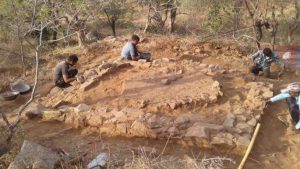Paubha artist Rajani Sinkhwal’s Mahakala (2023), a worthy successor piece to her father’s traditional legacy. Sujan Dangol’s arresting vision of a tower of deities atop a chariot (Rato Machindranath 2023). Mahima Singh’s installation of the Buddha’s first sermon, with an emphasis on light and impermanence (Transcendence Through Simplicity 2023). The artworks exhibited on the grounds of the Museum of Nepali Art (MoNA) are an attestation to the creativity that Nepal’s minds are capable of. They are part of the Kathmandu Art Biennale: Spiritual Edition.
The biennale and MoNA itself are the brainchildren of the owner of the Kathmandu Guest House (KGH) hotel group, Rajan Sakya. Sakya inherited the domestic hotel chain from his father and has managed eight hotels for decades. By his own admission, he is more interested in the artists than the art they make. In the last few years since finding his life’s calling, he has devoted his resources to not only channeling the country’s artistic energy into the biennale—there were over 80 artists exhibited—but also into helping the Nepali people appreciate the country’s art, to beckon them to the celebration of locally produced beauty.
One of the directors of MoNA, Shaguni Sakya, has many informed perspectives when it comes to art appreciation. During the pandemic, she took up the study of art history, alongside being a partner and mother, and she has been one of the most articulate biennale participants. Short of finding art historians at Nepal’s universities, I found Shaguni’s insights into how artists have portrayed spiritual subjects over the years extremely helpful. What I have learned from her and MoNA’s colleagues, and from my visit as a whole to the biennale’s opening, is that the Nepali art world has the intellectual tools for self-understanding: it just needs to trickle down from the lofty academies and universities to the right people, especially when appreciation for local artists (and a lack of awareness about their work) is lacking in the country.

The chosen theme for this first biennale gives some indication, by Sakya and Shaguni’s own admission, into the character of “Nepalese art” as a national classification. To encounter Nepalese art is, to some extent, also encounter a spiritual creation, steeped in tradition and religious life as the Himalayan region has been for centuries. Yet “spiritual” does not demand religious belief or affiliation, and it can also be strikingly modern, as many examples at the biennale prove: Abhijeet Prajapati, Mukesh Shrestha, and Sundar Lama are some of my favorite examples.
“There are two broad categories of art in today’s Nepal, one being contemporary art and the other traditional. On the latter, we suffer from a paucity of primary materials of just how paubha proliferated throughout what we know today as modern-day Nepal. An estimation, no matter how hagiographic, is the story of how the Licchavi Kingdom’s princess, Bhrikuti Devi was married to the Tibetan emperor Songtsen Gampo, along with the Chinese princess Wencheng. At the very least, this legend gives some indication of the kind of Nepali art that was brought into Tibet during that era,” Shaguni told me.
Based on this admittedly shaky historiography, traditional Nepali art and paubha’s antecedents correlate with but do not necessarily correspond to the period of the architecture and aesthetics that spawned Jokhang Temple, which was built during the reign of Songtsen Gampo. “From the 12th century onward, all the way to the 1940s, there was no systematic study of Nepali art, only the continuous transmission of traditional art. Then Ananda Muni Sakya (1904–44), influenced by Western painting styles, became commissioned by the 13th Dalai Lama for his exquisite paubha art. Sadly, this period came to an abrupt end with his early death, just as he was at the cusp of pioneering a new artistic style,” said Shaguni. She says that there was a sudden and prolonged pause in the evolution of traditional art from Muni Sakya’s death until the 90s.
The case is different for contemporary art, where the first generation of artists appear in the 60s and 70s, with Lain Singh Bangdel (1919–2002) redefining Nepalese art with his introduction of Western-themed art with his exhibition in 1962. The “Bangdel era” was followed by trailblazers like Kiran Manandhar, who articulated (and continues to articulate, as his contribution to this biennale, Pancha Tatva 2023, proves) for current and future artists emotions in art, from joy to sorrow, thoughts on social issues, and impressions of abstract concepts like truth and love, peace and violence.
“We can see that contemporary art starts to influence incoming generations of paubha artists,” said Shaguni, invoking Ananda Muni Sakya’s abortive legacy. “As the decades pass, more paubha works begin to demonstrate a more human feeling and flow, and no longer look completely two-dimensional. Here we see the beginnings of neo-traditional paubha.” Conversely, the influence of spiritual motifs can be found animating the work of contemporary artists, from Buddhism to Hinduism to local Nepali folklore. Hence a mutual synthesis has emerged, this harmonious interplay of old and new expressed in the biennale’s installations and paintings.
Shaguni is realistic about the activity of charting art as a commentator or historian in the spirit of critical enquiry: “Surveying art’s history is a luxury,” she concedes, “and most artists don’t have time to study history, even that of their own craft. Yet the power of Nepalese art lies in its authenticity, which is tied to its local, small-scale heritage. I have many Indian and Chinese visitors saying to me how viewing Nepalese art gives them a sense of inner peace. It is thanks for years of honing our soft strengths: heritage, tradition, spirituality – and our lack of commercialization.”
While commercialization does not necessarily go hand-in-hand with popularization (which the biennale does hope to do with its artists), one can see concerns about balance everywhere: communicating and publishing in Nepali versus doing so in English, expressing one’s inner world versus adhering to set artistic traditions, and abstraction for contemplating the universal versus making art for specific ritual purposes. One of Shaguni’s favorite pieces embodying the unity of the swanky new with the venerable old is Manish Dhoju’s work Royal Gold Window (2023), one of the first examples of hyperrealism in Nepal. The question for the future is a matter of balancing the contemporary and the traditional, because it is directly related to how present and future generations relate to art.
“Earning global appeal will inevitably bring some degree of ‘marketization’ of Nepali art, and we do not want to lose our souls,” is Shaguni’s conclusion. “Traditional art has its advantages: today’s young artists do not have the same strengths of yesteryear’s masters, like their concentration and ability to memorize.” Everything demands a delicate balance, highlighting in some way the fragility (and authenticity) of the Nepali art landscape: Nepali artists want their viewers to relate what is portrayed on canvas. The traditional will always be there. Now that the world is coming to Kathmandu for the biennale, the ongoing question is how Nepal will go to the world, bringing its magnificent heritage of art with it.
Related news from BDG
Kathmandu Showcases Traditional and Contemporary Nepali Art with the Museum of Nepali Art’s First Art Biennale
Italian Architect Unveils Ambitious Plan for New Buddhist Meditation Center in Nepal
Nepal Inaugurates Newly Restored Fifth-Century Buddhist Monument near Kathmandu
Related features from BDG
Journey to the Buddha’s Homeland: Rediscovering Pilgrimage Sites in Nepal
Related blog posts from BDG
Art Renaissance in Nepal: Ursula Manandhar and the Bridge Between Paubha and Neo-Traditional

















